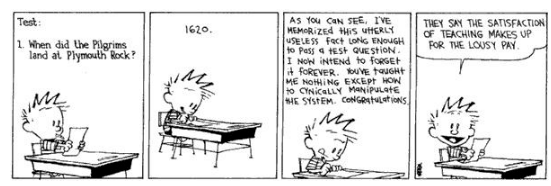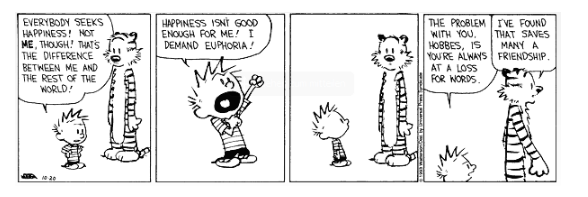- GIVING
EXAMPLES
Calvin and Hobbes is unquestionably one of the most
popular comic strips of all time. (A comic strip is a series of drawings used
to tell jokes.) It’s about the adventures of Calvin, a six-year-old with an
overactive imagination, and Hobbes, his stuffed toy tiger.
Words
to Know
·Wanders (panel 1) — To walk slowly and casually.
·African plain (panel 1) — A
plain is a large flat area of land.
·Ton (panel 2) — 2,000 pounds or about 900 kilograms.
·Deafening (panel 3) — A sound so loud that it will
make you deaf.
·Shatter (panel 3) — To break violently into pieces.

Strips
like these are what make Calvin and Hobbes so much better than other comics. Here,
we explore Calvin imagining himself as an elephant innocently wandering through
the African plains only to find out what he’s actually doing
in the final panel: being a mischievous (i.e. someone who likes to cause
trouble in a playful way) little boy, pulling a prank (i.e. a practical joke)
on his parents.
Words
to Know
·Who knows? (panel 2) — This is used to imply that you don’t know
the answer to the question and don’t really care. For example: What are the
characters’ names on the reality TV show Jersey Shore? —Who
knows?
·Who cares? (panel 3) — You say who cares? when
you want to imply that you don’t care at all, and you don’t think anyone else
does either.

This panel begins to introduce the character Susie, who Calvin likes but tries to cover it up (cover it up means to hide) by always doing mean things and making fun of her. (You can see a full length cartoon with her at the end of the article.)
Words
to Know
·Set fire (panel 1) — to intentionally put something on fire.
You can also say to set something on fire or
to light something on fire.
·She’s on to me (panel 4) — When someone is on to you they
know what you’re thinking, they understand your intentions.

Here
Calvin is asking absurd requests of his mom in order to make the question, “Can
I have a cookie?” not seem so bad. However, this plan doesn’t work which leads
Calvin to think “She’s on to me.”
Words to Know
·Utterly (panel 3) — completely.
·Cynically (panel 3) — doubtful as to whether something is
worthwhile.
·Lousy (panel 4) — very bad.

Bill
Watterson is criticizing the U.S.’s public education systems, saying how they
only teach children to memorize useless information instead of teaching them
anything useful, worthwhile, or practical.
Words
to Know
·Words fail me (panel 4) — I’m speechless (without words), words
can’t describe how I feel, I can’t think of anything to say.
·Keep in mind (panel 4) — Remember.
·Transmogrification (panel 4) — To transform into a different shape,
especially something that is unusual or strange.

This
strip introduces a long line of jokes as Calvin as a tiger.
Words
to Know
·Go into shock (panel 1) — When blood pressure drops too low to get
enough blood to your body. Symptoms include cold yet sweaty skin, weak and
rapid pulse (how fast your heart beats).
·Scam (panel 2) — Fraud, a dishonest scheme
·Deadman’s float (panel 3) — When you float on your back in the
water.

This
panel is making fun of little suburban kids who are forced to take swimming
lessons against their will and are irrationally (i.e. unreasonably) afraid of
them.
Words
to Know
·Trick question (panel 4) — Trick questions are when someone
asks a question they already know the answer to in order to confuse someone.
The question can have no correct answer or when the answer is no as simple as
it seems.
For example, the initial response to What do you put into a toaster? is toast, which is incorrect. You put bread into a toaster and it turns into toast.
For example, the initial response to What do you put into a toaster? is toast, which is incorrect. You put bread into a toaster and it turns into toast.

A great
strip that just shows Calvin just being a kid. The mom has a normal reaction,
“What are you doing?!” and Calvin thinks the answer is pretty obvious…
Words
to Know
·A man of few words (panel 1) — Someone who is able to make a point
without needing to use a lot of words. Someone who can describe things well. It’s
usually used as a compliment.

Here you get a glimpse of Hobbes’ “smart-ass” (i.e. sarcastic) humor. Calvin says with dignity (as you can tell by the expression on his face), that he is “a man of few words,” which Hobbes makes it into meaning that Calvin doesn’t know many words and therefore isn’t very smart.
Words
to Know
·Seeks (panel 1) — Is looking for.
·Euphoria (panel 2) — A feeling of intense excitement and
happiness.
·At a loss for words (panel 4) — This means to have nothing to say, to be
speechless.
·…Many a friendship (panel 4) — Hobbes is saying that his silence
has prevented many people from disliking him.

Here,
Calvin is making some absurd statements that Hobbes prefers to not to comment
about. When Calvin makes fun of him for it, Hobbes implies if you
don’t have anything nice to say, don’t say anything at all. This
strip shows Hobbes as a man of few words.
Words
to Know
·Fold (panel 4) — Fold is the word you say in poker
when you want to quit on “the hand,” or throw your cards away and not bet
anymore money on the round.

Notice
Hobbes’ tail in the third panel.
Words
to Know
·Patient (row 1, panel 2) — Someone who is waiting to see a
doctor.
·Tongue depressor (row 1, panel 2) — A device used to examine the mouth
and throat.
·Like I care (row 2, panel 1) — A sarcastic way to say that you
don’t care at all.
·Find out (row 2, panel 2) — Issue a warning.
·Psychosomatic (row 2, panel 3) — A physical illness caused by mental
problems.
·Lobotomy (row 2, panel 3) — A type of brain surgery, often
used for mental patients.
·Saw (row 2, panel 3) — A big, knife-like tool used
to cut down trees, among other things.
·Stethoscope (row 2, panel 3) — A medical tool used to listen
to a heartbeat or breathing, it’s often worn around a doctor’s neck.
·Mallet (row 2, panel 4) — A hammer with a large wooden
head.
·Anesthesia (row 2, panel 4)— A drug used to dull pain in medical
procedures.
·Shot (row 3, panel 1) — To receive a vaccination
through an injection.
·Shot in the mouth (row 3, panel 1) — A punch in the mouth.
Calvin
and Hobbes include many brilliant strips like these showcasing the imaginative
power of little kids (i.e. children). In the beginning of the strip, Calvin and
Susie appear to be an adult doctor and his patient, respectively. But as the
comic continues, you notice how childish/immature the adults are acting, only
to find towards the end of the comic that the adults are actually Calvin and
Susie playing Doctor.
In this frame from a comic, a visual metaphor is used.
What is it?

This activity requires student collaboration and
creativity.
1. Make enough copies of the comic strip for your students.
2. Cut it up in frames.
3. Give a set to each pair/group.
4. Students work in pairs and organize the frames in sequence.
5. Students write the lines for each balloon.
6. Students share their stories.
7. Students check the original sequence.
8. Students compare their stories to the original comic strip.
9. Students choose the story they like the most.
1. Make enough copies of the comic strip for your students.
2. Cut it up in frames.
3. Give a set to each pair/group.
4. Students work in pairs and organize the frames in sequence.
5. Students write the lines for each balloon.
6. Students share their stories.
7. Students check the original sequence.
8. Students compare their stories to the original comic strip.
9. Students choose the story they like the most.
This is an activity for conversation time in
class.
1. Students dicuss the questions in small groups.
2. Individual work: Students complete the comic strip with the past tense of the verbs.
3. Peer check: Students chech their answers in pairs.
4. Show the slide and check with the whole group.
5. Pair work: Students read the comic strip and discuss the questions in pairs.
6. Homework: web search.
1. Students dicuss the questions in small groups.
2. Individual work: Students complete the comic strip with the past tense of the verbs.
3. Peer check: Students chech their answers in pairs.
4. Show the slide and check with the whole group.
5. Pair work: Students read the comic strip and discuss the questions in pairs.
6. Homework: web search.
This is a reading activity that also promotes language
awareness. Students have to analyse the language so as to be able to organize
the frames into the original cartoon.
1. Make as many copies of the cartoon as necessary.
2. Cut the it up in frames.
3. Give a set to each pair/group.
4. Students work together to organize the frames.
5. Check their work.
Then have a class discussion:
a) What helped you identify the sequence of the story?
b) Which words were they?
c) Which words can you use to help you organize a sequence of events? Make a list of them.
d) Now write a story using these words to organize it.
1. Make as many copies of the cartoon as necessary.
2. Cut the it up in frames.
3. Give a set to each pair/group.
4. Students work together to organize the frames.
5. Check their work.
Then have a class discussion:
a) What helped you identify the sequence of the story?
b) Which words were they?
c) Which words can you use to help you organize a sequence of events? Make a list of them.
d) Now write a story using these words to organize it.

Diferents comic strips
1. Match the following sentences to the onomatopoeia that describes them.
- A plate being dropped on the floor.TINKLE
A balloon being burst. BANGA gun being shot. SMASHSomeone eating crisps. GROWLA light being switched on.POPA fierce dog. CRUNCHA small bell being rung.CLICK
2. Put each onomatopoeia into a sentence.
a Ouch! b Hmmm c Shhh… d Hah! e Mmmmm
f Oops! g Ah hah!!! h Phew! i Whew! j Splash
1 You are cheating at a test and you see the teacher coming in your direction.
2 You finally understand something.
3 You’re eating a delicious piece of cake.
4 Your friend takes off his smelly shoes.
5 You’re watching TV and you want everyone to be quiet.
6 You drop a baloon full of water on the floor
7 You get a test back. You needed 12 to pass, you thought you failed but you got 13.
8 You dropped a heavy book on your foot.
9 You find out that you were right and your friends were wrong.
10 You are thinking about something. (Let me see…)


